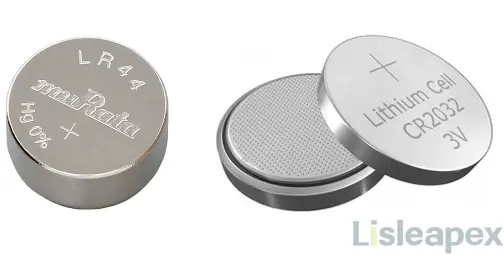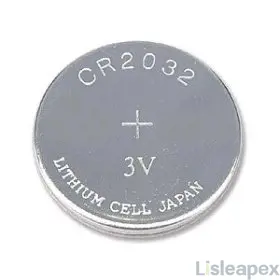Button cell batteries are essential components powering a myriad of electronic devices, from small gadgets to household appliances. Two prominent types in this category are the CR2032 and LR44 batteries. Each boasts distinct characteristics, applications, and specifications that cater to different needs in the electronics market.

What is CR2032
The CR2032 battery is a type of lithium coin cell known for its stable voltage output and long-lasting power. With a nominal voltage of 3.0 volts, it is commonly used in a wide range of electronic devices requiring reliable energy sources. The "CR" prefix denotes its cylindrical lithium chemistry, while "2032" specifies its dimensions, with a diameter of 20mm and a height of 3.2mm.

Due to its compact size and consistent performance, the CR2032 finds applications in various devices, including watches, calculators, keyless entry remotes, computer motherboards for maintaining real-time clocks, medical devices, and small electronic gadgets. Its extended shelf life and dependable power make it a popular choice for devices requiring sustained energy over time.
What is LR44
The LR44 battery is an alkaline button cell renowned for its affordability and widespread use in low-drain electronic devices. With a nominal voltage of 1.5 volts, it is denoted by the "LR" prefix indicating its cylindrical alkaline chemistry, coupled with the standard size code "44".

Typically smaller in size compared to other alkaline batteries, the LR44 is commonly employed in small toys, LED blinky lights, laser pointers, digital thermometers, remote controls, and handheld calculators. While it may not offer the same voltage as the CR2032, the LR44 provides a cost-effective power solution for devices with intermittent or low power requirements, making it a versatile option in the realm of button cell batteries.
CR2032 vs LR44: Dimensions

CR2032 Dimensions

LR44 Dimensions
CR2032 vs LR44: Chemical Material
The CR2032 and LR44 batteries differ not only in their chemical composition but also in their physical form and applications. The CR2032, a lithium-based coin cell, boasts a compact design and relies on lithium chemistry for power generation. This chemistry ensures a stable voltage output over its lifespan. In contrast, the LR44, classified as an alkaline button cell, contains alkaline chemistry, providing a reliable power source for various electronic devices.
CR2032 vs LR44: Specifications
CR2032 Specifications
- Classification: Lithium Coin
- Chemical System: Lithium / Manganese Dioxide (Li/MnO2)
- Designation: ANSI / NEDA-5004LC, IEC-CR2032
- Nominal Voltage: 3.0 Volts
- Typical Capacity: 235 mAh (to 2.0 volts) (Rated at 15K ohms at 21°C)
- Typical Weight: 3.0 grams (0.10 oz.)
- Typical Volume: 1.0 cubic centimeters (0.06 cubic inch)
- Max Reverse Charge: 1 microampere
- Energy Density: 198 milliwatt hr/g, 653 milliwatt hr/cc
- Typical Lithium Content: 0.109 grams (0.0038 oz.)
- Operating Temperature: -30°C to 60°C
- Self Discharge: ~1% per year
LR44 Specifications
- Nominal Voltage: 1.5 volts
- Cutoff Voltage: 0.9-1.0 volts (depends on device cutoff voltage)
- Minimum Open Circuit Voltage (OCV): 1.50 volts
- Minimum Voltage at -10℃ with 200 ohms load for 5 seconds (CCV): 1.10 volts
- Minimum Capacity (at 4.7k ohms to 0.9 volts): 08 mAh
- Terminals: Flat contacts
- Average Weight: 2.0 grams
- Average Service Capacity (at 0.9 volts): 120 mAh (rated capacity at 4.7k ohms at 23℃)
CR2032 vs LR44: Application
CR2032 Battery Applications:
- Clocks: Used to power the clock mechanisms in wall clocks, desk clocks, and alarm clocks.
- Timers: Employed in various timing devices such as kitchen timers, countdown timers, and interval timers.
- Computer Clock Circuits: Utilized to maintain the real-time clock (RTC) function in computers, ensuring accurate timekeeping even when the computer is powered off.
- Remote Controls: Found in remote controls for devices like televisions, DVD players, and air conditioners.
- Medical Devices: Used in small medical devices such as glucose meters, thermometers, and blood pressure monitors.
- Key Fobs: Powering the remote keyless entry systems in cars and other vehicles.
- Small Electronic Gadgets: Providing power for devices like digital thermometers, pedometers, and electronic toys.
LR44 Battery Applications:
- Multimeters: Powering the digital displays and measurement functions in handheld multimeters used for electrical testing.
- LED Blinky Lights: Used in novelty LED toys, light-up keychains, and flashing novelty items.
- Laser Pointers: Providing power for laser pointers used in presentations, lectures, and demonstrations.
- Small Toys: Found in a variety of small electronic toys such as electronic pets, handheld games, and musical toys.
- Calculators: Powering the display and computation functions in small electronic calculators.
- Watches: Used in some digital watches, particularly those with additional features such as alarms or backlighting.
- Remote Controls: Occasionally used in remote controls for simple devices like garage door openers and small appliances.
CR2032 vs LR44: Battery Lifespan
CR2032 Battery:
When stored under optimal conditions—such as in a dry, climate-controlled environment without physical damage—CR2032 batteries can have a shelf life of up to 10 years. However, the actual service life of a CR2032 battery in a device depends greatly on its usage. For example, in a car key fob where battery usage is intermittent, a CR2032 battery may last approximately 4-5 years before requiring replacement. Conversely, in more active devices such as the Apple AirTag, which continuously tracks objects, the CR2032 battery may last only about a year due to more frequent usage.
LR44 Battery:
Similar to the CR2032, the lifespan of LR44 batteries can vary based on usage and storage conditions. While LR44 batteries typically have a shelf life of several years when stored properly, their service life in devices depends on the specific application. In devices with intermittent use, such as certain types of toys or remote controls, an LR44 battery may last for an extended period—potentially several years—before needing replacement. However, in devices that require frequent or continuous power, such as LED blinky lights or laser pointers, the LR44 battery may need to be replaced more frequently, possibly within a few months to a year.
CR2032 vs LR44: Equivalent Parts
When it comes to battery replacements, both the CR2032 and LR44 have several equivalents that can be used interchangeably based on specific requirements.
For CR2032 Battery Equivalents:
Similarly, the CR2032 battery, a popular lithium coin cell, can be substituted with equivalent parts to meet different needs. One common replacement is the CR2025 battery, which shares similar characteristics and is often used interchangeably. The CR2025 offers a slightly thinner profile, making it especially suitable for applications with limited mounting space while still delivering reliable power performance akin to the CR2032.
For LR44 Battery Equivalents:
The LR44, known for its 1.5V alkaline power, finds compatibility with various equivalent batteries. Common replacements include the AG13, L1154, LR1154, and 157. Additionally, for those seeking longer-lasting power, silver oxide equivalents such as the SR44, SR44SW, 303, and 357 can also serve as suitable alternatives.
Differences between CR2032 and LR44 (Complete Guide)
The CR2032 and LR44 are two common types of button cell batteries used in various electronic devices. The CR2032 is a lithium coin cell known for its stable voltage output and long-lasting power, with a nominal voltage of 3.0 volts. On the other hand, the LR44 is an alkaline button cell with a nominal voltage of 1.5 volts, renowned for its affordability and versatility. Despite their differences in chemistry and voltage, both batteries serve essential roles in powering devices such as watches, calculators, remote controls, and small electronic gadgets.
|
Aspect |
CR2032 |
LR44 |
|
Battery Type |
Lithium Coin Cell |
Alkaline Button Cell |
|
Nominal Voltage |
3.0 Volts |
1.5 Volts |
|
Chemistry |
Lithium / Manganese Dioxide (Li/MnO2) |
Alkaline |
|
Designation |
ANSI / NEDA-5004LC, IEC-CR2032 |
Standard size code "44" |
|
Dimensions |
Diameter: 20mm, Height: 3.2mm |
Typically smaller |
|
Typical Capacity |
235 mAh (to 2.0 volts) |
120 mAh (rated capacity at 0.9 volts) |
|
Weight |
3.0 grams (0.10 oz.) |
2.0 grams |
|
Typical Volume |
1.0 cubic centimeters (0.06 cubic inch) |
- |
|
Max Reverse Charge |
1 microampere |
- |
|
Energy Density |
198 milliwatt hr/g, 653 milliwatt hr/cc |
- |
|
Operating Temperature |
-30°C to 60°C |
- |
|
Self Discharge |
~1% per year |
- |
|
Applications |
Watches, calculators, keyless entry remotes, computer motherboards, medical devices, small electronic gadgets |
LED blinky lights, laser pointers, digital thermometers, remote controls, small toys, watches |
|
Battery Lifespan |
Up to 10 years (shelf life) |
Several years (shelf life), varies based on usage and storage conditions |
|
Equivalent Parts |
CR2025, SR44, SR44SW, 303, 357 |
AG13, L1154, LR1154, 157 |
Conclusion
In the vast landscape of button cell batteries, the CR2032 and LR44 stand out as indispensable power sources for an array of electronic devices. Whether it's the CR2032's dependable performance in timekeeping applications or the LR44's cost-effective solution for small toys and gadgets, both batteries play vital roles in powering our modern world. With their distinct specifications and applications, the CR2032 and LR44 continue to be pillars of reliability and efficiency in the electronics industry.
Related Post:
LR44 vs 357: Is LR44 Same as 357>>
LR44 VS SR44: Are they Interchangeable and How to Chooses>>
FAQ
-
Are CR2032 batteries more expensive than LR44 batteries?
Generally, CR2032 batteries tend to be slightly more expensive than LR44 batteries due to their higher capacity and longer shelf life. However, the cost difference may vary depending on factors such as brand, quantity, and seller.
-
Which devices commonly use LR44 batteries?
LR44 batteries are commonly used in devices such as calculators, thermometers, laser pointers, toys, digital cameras, and small electronic gadgets.
-
Which devices commonly use CR2032 batteries?
CR2032 batteries are commonly used in a wide range of devices, including watches, calculators, key fobs, remote controls, medical devices, fitness trackers, and small electronic gadgets.
-
Can CR2032 batteries be used interchangeably with LR44 batteries?
In some cases, CR2032 and LR44 batteries may be used interchangeably, especially if the device can accept both voltage levels. However, due to the difference in voltage and chemistry, it is generally recommended to use the appropriate battery type specified by the device manufacturer to ensure optimal performance and compatibility.
-
What is the difference between CR2032 and LR44 batteries?
The main difference between CR2032 and LR44 batteries lies in their chemistry and voltage. CR2032 batteries are lithium coin cell batteries with a nominal voltage of 3 volts, while LR44 batteries are alkaline coin cell batteries with a nominal voltage of 1.5 volts. Additionally, CR2032 batteries typically have a higher capacity and longer shelf life compared to LR44 batteries.
Stay updated with Lisleapex by signing up for the newsletter


 Congratulations On Your Successful Submission
Congratulations On Your Successful Submission
 Submission Failure
Submission Failure